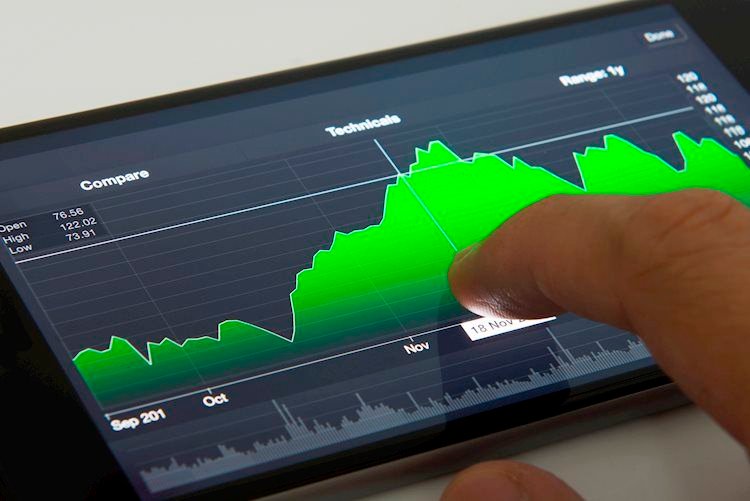- US stock index futures trade marginally higher following Monday’s choppy action.
- January Durable Goods Orders data will be featured in the US economic docket.
- Stock markets could react to US PCE inflation figures later in the week.
S&P 500 futures rise 0.06%, Dow Jones futures are unchanged, and Nasdaq futures gain 0.15% ahead of the opening bell on Tuesday.
S&P 500 (SPX), Dow Jones (DJIA), and Nasdaq (IXIC) indexes closed on Monday with a 0.38% loss, a 0.16% drop, and a 0.13% fall, respectively.
What to know before stock market opens
The Energy Sector rose 0.32% on Monday as the best-performing major S&P sector for the day. On the other hand, the Utilities Sector fell 2.1%.
Palo Alto Networks Inc. (PANW) and Domino’s Pizza Inc. (DPZ) shares were the top S&P 500 gainers on Monday, rising 7.33% and 5.84%, respectively. Insulet Corp. (PODD) lost nearly 8.4% on the day as the biggest decline, closely followed by Alphabet Class C and Class A shares, shedding 4.5% and 4.4% apiece.
Reviewing Monday’s action in global equity markets, “as we started a new week equities struggled to maintain their spectacular recent momentum, with the S&P 500 -0.38% lower on Monday,” said Jim Reid, global head of economics and thematic research at Deutsche Bank, and continued:
“The NASDAQ declined a marginal -0.13%, while the Magnificent 7 were down -0.39%, dragged lower by a -4.44% decline for Alphabet amid concerns over recent missteps with its AI model. Small-cap stocks were the strongest performers, with the Russell 2000 up +0.61%. Over in Europe the picture was more negative though, with the STOXX 600 down -0.37% as it fell back from its all-time high on Friday. Even so, it wasn’t all bad news there, as the DAX (+0.02%) eked out a new record, and Euro HY spreads reaching their tightest level in over two years.”
Inflation FAQs
Inflation measures the rise in the price of a representative basket of goods and services. Headline inflation is usually expressed as a percentage change on a month-on-month (MoM) and year-on-year (YoY) basis. Core inflation excludes more volatile elements such as food and fuel which can fluctuate because of geopolitical and seasonal factors. Core inflation is the figure economists focus on and is the level targeted by central banks, which are mandated to keep inflation at a manageable level, usually around 2%.
The Consumer Price Index (CPI) measures the change in prices of a basket of goods and services over a period of time. It is usually expressed as a percentage change on a month-on-month (MoM) and year-on-year (YoY) basis. Core CPI is the figure targeted by central banks as it excludes volatile food and fuel inputs. When Core CPI rises above 2% it usually results in higher interest rates and vice versa when it falls below 2%. Since higher interest rates are positive for a currency, higher inflation usually results in a stronger currency. The opposite is true when inflation falls.
Although it may seem counter-intuitive, high inflation in a country pushes up the value of its currency and vice versa for lower inflation. This is because the central bank will normally raise interest rates to combat the higher inflation, which attract more global capital inflows from investors looking for a lucrative place to park their money.
Formerly, Gold was the asset investors turned to in times of high inflation because it preserved its value, and whilst investors will often still buy Gold for its safe-haven properties in times of extreme market turmoil, this is not the case most of the time. This is because when inflation is high, central banks will put up interest rates to combat it.
Higher interest rates are negative for Gold because they increase the opportunity-cost of holding Gold vis-a-vis an interest-bearing asset or placing the money in a cash deposit account. On the flipside, lower inflation tends to be positive for Gold as it brings interest rates down, making the bright metal a more viable investment alternative.
Stock markets await US data
The US Census Bureau will release Durable Goods Orders data for January ahead of the opening bell on Tuesday. Markets expect Durable Goods Orders to decline 4.5% after staying unchanged in December. Durable Goods Orders ex Transportation is forecast to rise 0.2%.
The US Bureau of Economic Analysis will announce the second estimate of the Gross Domestic Product (GDP) growth for the fourth quarter on Wednesday. Personal Consumption Expenditures (PCE) Price Index, the Federal Reserve’s (Fed) preferred gauge of inflation, figures will be scrutinized by market participants on Thursday.
New York Fed President John Williams said on Friday that he expects the US central bank to start lowering the policy rate in the second half of the year. According to the CME FedWatch Tool, markets are nearly fully pricing in a no change in the Fed policy rate in March and see an 85% probability of another pause in May.
Republic Services Inc. (RSG), Agilent Technologies Inc. (A), Extra Space Storage Inc. (EXR) and Coupang Inc. (CPNG) will release quarterly earnings after the closing bell on Tuesday.
S&P 500 FAQs
The S&P 500 is a widely followed stock price index which measures the performance of 500 publicly owned companies, and is seen as a broad measure of the US stock market. Each company’s influence on the computation of the index is weighted based on market capitalization. This is calculated by multiplying the number of publicly traded shares of the company by the share price. The S&P 500 index has achieved impressive returns – $1.00 invested in 1970 would have yielded a return of almost $192.00 in 2022. The average annual return since its inception in 1957 has been 11.9%.
Companies are selected by committee, unlike some other indexes where they are included based on set rules. Still, they must meet certain eligibility criteria, the most important of which is market capitalization, which must be greater than or equal to $12.7 billion. Other criteria include liquidity, domicile, public float, sector, financial viability, length of time publicly traded, and representation of the industries in the economy of the United States. The nine largest companies in the index account for 27.8% of the market capitalization of the index.
There are a number of ways to trade the S&P 500. Most retail brokers and spread betting platforms allow traders to use Contracts for Difference (CFD) to place bets on the direction of the price. In addition, that can buy into Index, Mutual and Exchange Traded Funds (ETF) that track the price of the S&P 500. The most liquid of the ETFs is State Street Corporation’s SPY. The Chicago Mercantile Exchange (CME) offers futures contracts in the index and the Chicago Board of Options (CMOE) offers options as well as ETFs, inverse ETFs and leveraged ETFs.
Many different factors drive the S&P 500 but mainly it is the aggregate performance of the component companies revealed in their quarterly and annual company earnings reports. US and global macroeconomic data also contributes as it impacts on investor sentiment, which if positive drives gains. The level of interest rates, set by the Federal Reserve (Fed), also influences the S&P 500 as it affects the cost of credit, on which many corporations are heavily reliant. Therefore, inflation can be a major driver as well as other metrics which impact the Fed decisions.
Information on these pages contains forward-looking statements that involve risks and uncertainties. Markets and instruments profiled on this page are for informational purposes only and should not in any way come across as a recommendation to buy or sell in these assets. You should do your own thorough research before making any investment decisions. FXStreet does not in any way guarantee that this information is free from mistakes, errors, or material misstatements. It also does not guarantee that this information is of a timely nature. Investing in Open Markets involves a great deal of risk, including the loss of all or a portion of your investment, as well as emotional distress. All risks, losses and costs associated with investing, including total loss of principal, are your responsibility. The views and opinions expressed in this article are those of the authors and do not necessarily reflect the official policy or position of FXStreet nor its advertisers. The author will not be held responsible for information that is found at the end of links posted on this page.
If not otherwise explicitly mentioned in the body of the article, at the time of writing, the author has no position in any stock mentioned in this article and no business relationship with any company mentioned. The author has not received compensation for writing this article, other than from FXStreet.
FXStreet and the author do not provide personalized recommendations. The author makes no representations as to the accuracy, completeness, or suitability of this information. FXStreet and the author will not be liable for any errors, omissions or any losses, injuries or damages arising from this information and its display or use. Errors and omissions excepted.
The author and FXStreet are not registered investment advisors and nothing in this article is intended to be investment advice.














